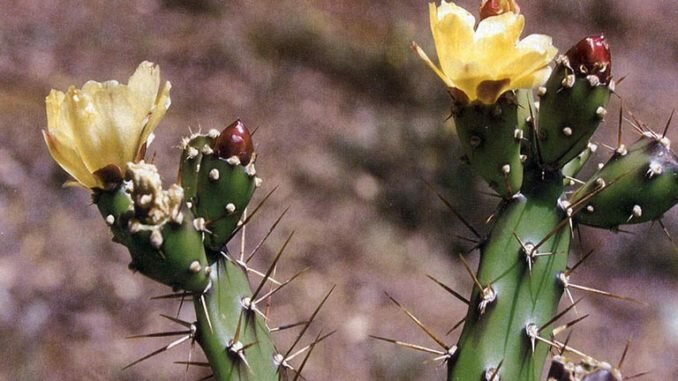
Thifhelimbilu Mulateli
Rhodes University – MSc
The jointed cactus, Opuntia aurantiaca, got a foothold in South Africa because it is pretty. It gave gardens a flavour of the exotic, with its barbed spines and many jointed stems which resemble long balloons tied in knots. Its delicate yellow flowers were an added attraction. So, gardeners planted this deadly invader. But cacti, unlike food crops, can reproduce asexually: one of its jointed limbs can fall off, and begin growing as an independent plant.
This hardy and prolific plant has now invaded pastoral lands across the country, threatening indigenous plants as well as the health of livestock. The Eastern Cape has been particularly hard hit by the jointed cactus, which was originally from Argentina and Paraguay. The similarity in climate made the province an ideal home for this plant.
The invasive alien species outcompetes indigenous plant varieties for resources such as water, sunlight, and nutrients. Also, their sharp spines make them not only a hindrance but a danger: they grow so densely that they become an impenetrable wall, stopping animals from grazing and humans from passing. Animals can also get stuck in these injurious thickets.
What this means practically is that an area with a high number of subsistence farmers has a weed threatening their livelihoods and the lives of their animals.
Mechanical clearing and chemical control, such as herbicides, are not effective when it comes to managing the jointed cactus. For one thing, pulling out the cactus can cause more problems than it solves: the joints detach easily and a single joint can create a new cactus plant, so even though you remove the original plant, the parts that fall off can create 10 more. This form of control is also labour intensive, and thus costly. Similarly, herbicides are expensive and sadly not particularly effective in killing these vast cactus populations.
Luckily, there is another solution: biological control. This form of control involves using an exotic insect to kill the invader. Although it is difficult to eradicate an invasive creature entirely – whether it is a plant or “pest” – these exotic predators can reduce the invader’s numbers to the point that it no longer threatens ecosystems or economies. This method has the added benefit of being self-sustaining once the exotic creatures have established themselves in the new ecosystem.
This is why researchers and agricultural authorities are pinning their hopes on a small insect covered in an armour of white, wooly wax that protects them from heat, cold and predators.
The cochineal insect, also known as Dactylopius austrinus, was first introduced to South Africa in 1935, and then again in the 1970s. These tiny insects have a particular liking for the jointed cactus: they attach themselves to the fleshy parts of the plant in large numbers, and look like cotton wool caught in its thorns and stuck to its surface. The insects suck out the cactus’s sticky juices, and damaged plants turn a sickly yellow or sometimes even black.
Despite having been in the country for more than 80 years, the cochineal insect is not winning the war against the jointed cactus in areas like the Eastern Cape.
That is why researchers are hatching a new strategy: the mass rearing and mass release of the cochineal insect in the Eastern Cape. In most biological warfare, insects are released once and then left to do their thing. But we’re hoping to boost their effects by releasing insects more than once, over time building up their numbers. When invasive infestations are stubborn, a mass release can give the exotic biological control agent the upper hand.
My study will determine how many mass releases we will need to control jointed cactus infestations.
The data will be used to compile a best practice protocol to beat back this voracious invader. Hopefully, later this year, and then again next year, our waxy wooly cochineal insects will descend on the Eastern Cape.

Leave a Reply